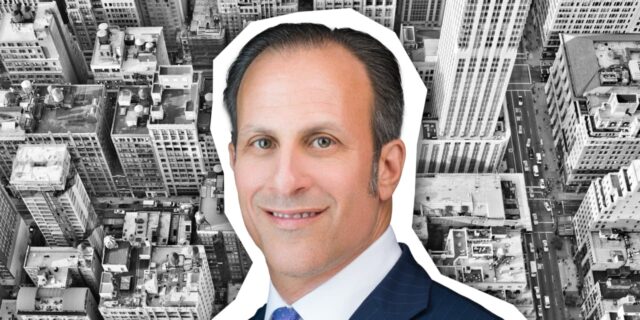Greg Lippmann, a central figure in “The Big Short,” Michael Lewis’s book about Wall Street’s role in the subprime-mortgage crisis, is readying his next big trade, this time on beaten-up commercial mortgage bonds.
“People think it’s going to be bad,” Lippmann said of distress in commercial real estate debt. “That creates opportunity.”
Lippmann, formerly a star Deutsche Bank
DB
trader, gained notoriety for betting against subprime-mortgage bonds before the market collapsed in 2008. After decades on Wall Street, he founded the hedge fund LibreMax Capital in 2010 to focus on structured financing, including buying the deeply discounted subprime bonds that he once bet against. LibreMax now manages $10.2 billion in assets.
Lippmann, the hedge fund’s chief investment officer, now sees a big opportunity for LibreMax in securities that helped finance a boom in offices, hotels, shopping centers and other property types in the past decade. Property prices have slumped, all but top-shelf office buildings are in trouble and U.S. commercial real estate has a mountain of debt coming due at much higher interest rates.
See: ‘No one is throwing good money after bad.’ Why 2024 looks like trouble for commercial real estate.
“We think that, in a lot of cases, this sector is being sold indiscriminately,” Lippmann said of the commercial mortgage-backed securities market in a MarketWatch interview. CMBSs are bonds backed by pools of property loans that Wall Street has sliced up into debt instruments with varying degrees of riskiness.
As with once-toxic subprime mortgage bonds, Lippmann anticipates higher recoveries in some commercial mortgage-backed securities than prices currently reflect. In 2013, Lippmann took a similar approach to discounted bonds backed by student loans without government guarantees.
Less than ‘horrible’
Expectations for the Federal Reserve to pivot this year to rate cuts have spurred optimism across financial markets, with U.S. stocks returning to record territory, evidenced by the S&P 500
SPX
and Dow Jones Industrial Average
DJIA
reclaiming peak levels set two years ago.
Credit markets also have rallied broadly, even with parts of the CMBS market still looking priced for “horrible” outcomes, Lippmann said.
Lippmann’s team is betting it can cherry-pick bonds at bargain prices that produce less dire outcomes than others anticipate, using their own risk models, reams of data and gumshoe detective work to reap big rewards.
“It’s not a short,” Lippmann said of the strategy. It also isn’t a wholesale approach to buying just any cheap bond, especially with an estimated $1.2 trillion in commercial real-estate debt coming due through 2025. “There are a lot of reasons to be cautious,” he said.
Read: San Francisco’s Westfield mall sees value slashed by 75% — erasing nearly $1 billion
Rather than focus on bonds backed by single trophy buildings, LibreMax is looking for older, mispriced securities backed by pools of loans on different property types, or conduit bonds, which can be more complicated to underwrite than a single skyscraper in Manattan.
A batch of older investment-grade BBB-rated conduit bonds out for bid in January saw price talk of $42 to $65, according to Empirasign, which tracks trading activity in the secondary market. When bonds can avoid losses and fully repay at maturity, they pay the holder their full face value, or $100. LibreMax also sees an edge in riskier securities rated below investment-grade.
New bond supply in the sector has been sparse since the Fed began ratcheting up its policy rate to a 22-year high of 5.25% to 5.5%, making credit for landlords more difficult and more expensive to come by. After the Fed in December signaled a pivot to cuts was coming, a batch of newly issued CMBS sold in January has been met with strong investor demand, even though BBBs and lower-rated securities are still being issued at steep discounts.
Arbitrage
LibreMax isn’t alone in seeing upside in downtrodden commercial mortgage-backed securities.
“Dollars are looking at this market,” said Morris Chen, a portfolio manger at Jeffrey Gundlach’s DoubleLine Capital, which had $95 billion in assets under management at the end of December. “We ourselves are trying to understand ultimately what is the intrinsic value of the underlying assets,” he told MarketWatch.
While much hasn’t changed in terms the fundamental pressures facing many commercial property markets, Chen said new optimism was sparked when the Fed signaled a pivot to rate cuts was likely this year.
Investors no longer see a need to “price to a super draconian scenario” in commercial real estate, Chen said, pointing to a backdrop where rates on new mortgage loans continue to climb. Rates on commercial property loans hit lows of 3% to 3.5% in the past decade but last year rose as high as 7.5% on average, putting a squeeze on owners with debt maturing.
“In this environment, you can be a little blunt,” Chen said of expectations for Fed rate cuts. He also said that while DoubleLine has been cautious, the firm hasn’t been shying away from the CMBS market.
The firm last spring launched a new exchange-traded fund called DoubleLine Commercial Real Estate ETF
DCMB,
which has been up 0.4% on the year so far, according to FactSet. DoubleLine across its investment strategies can buy lower-rated CMBSs, but the ETF is focused on higher-rated bonds in the AAA to single-A category. It also will change its ticker symbol to “DCRE” effective Feb. 1.
Lippmann declined to say whether LibreMax was raising new funds for distress in the CMBS market but said he sees it as a multiyear opportunity.
“Everyone knows commercial real estate has gone down in price,” Lippmann said. “The opportunity isn’t going away in the next three months.”




